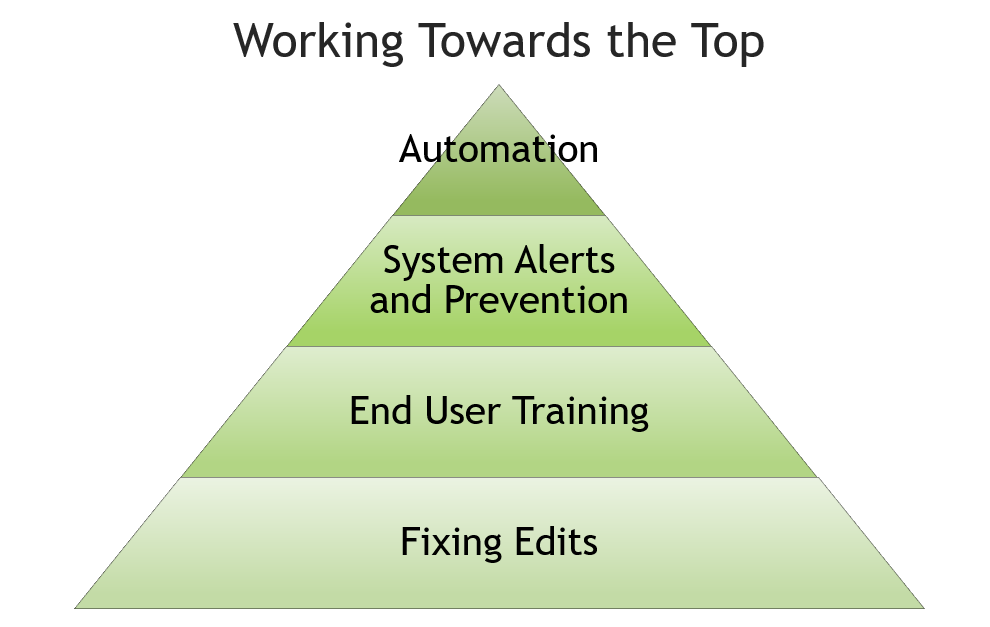We all know that quality registration forms the bedrock for a high-quality revenue cycle.
But how do we get there? How do we create an environment for good registration process and an emphasis on continuous improvement?
The Hierarchy to High-Quality Registration
I like to think about it as a hierarchy. The bottom of the hierarchy represents where our teams likely spend most of our time. This is the never-ending lists and queues of registration edits that we work to meet our daily and weekly goals. The true efficiencies and improvements can only be realized at the top of the pyramid, where you leverage intelligent alerts and automation within your HIS to prevent issues from happening in the first place.
To reach registration self-actualization, you need to create a structure that emphasizes a combination of communication and feedback, root-cause analysis, and system enhancements and automation. Don’t worry though, you won’t need a degree in psychology to turn your registration process into a well-oiled machine.

The 4 levels of registration process improvement:
Level 1: Fixing Edits
At the lowest level, we are simply resolving edits so that we can continue to get bills out the door. Workgroups and “SWAT” teams can be used to target high dollar and high-volume edits but ultimately focusing your efforts here will leave you in a continuous cycle of dedicating resources to resolve registration issues. Edit resolution takes priority over edit prevention.
- Where it can be useful– right after a go-live where volumes are high; making big pushes to reach revenue targets
- Drawbacks – no feedback to prevent issues going forward; can be very time and labor-intensive
Level 2: End User Training and Communication
Once we have groups of users with the knowledge and experience to resolve difficult edits, we need to create a process for communicating the issues to the rest of the registration team and create supporting training materials. Training users on common mistakes will help to prevent similar issues going forward. Training alone will likely fully not address the issues though as there is still margin for error and the potential to misunderstand what the correct process is.
- Where it can be useful– preventing common and simple registration issues.
- Drawbacks – typical training shortcomings; its difficult to reach all users with training. Training can’t always easily address the more complex registration issues and scenarios.
Level 3: System Alerts and Prevention
The best way to reduce the volume of registration errors, of course, is to prevent them from happening in the first place. Staff need to know they are making mistakes so that they can be corrected in real-time and not need to be fixed later. Typically, this means working with your IT team to create alerts during the registration process to notify users of issues. Within Epic, for example, you can build warnings and pop-ups so that users are encouraged (or forced) to fix the problem prior to it falling to a workqueue. Some organizations will also utilize third-party registration quality products that come with built-in alerts and notifications.
- Where it can be useful– targeting simple mistakes; creating an accountability structure for managers and team members.
- Drawbacks – organizations can create so many alerts that end users either ignore them (alert fatigue) or become bogged down with resolving them, increasing registration timing.
Level 4: Automation
The holy grail of quality registration is designing automated processes that take out end user intervention entirely. This strategy can’t be utilized for every registration input but there are many scenarios where you can leverage automation. An example of this may be creating logic to automatically select the correct insurance plan based on information in the RTE response rather than having an end user choose from a list of possible plans.
- Where it can be useful– complex if-then scenarios that have consistent logic or leverage data inputs from an outside source that doesn’t need to be entered. Examples are insurance plan selection, filing address information, filing insurance plan benefits data, etc.
- Drawbacks – not every data input can be automated, and some scenarios have too many uncertainties to be programmed.
Where do you spend most of your time on the pyramid? Are you fulfilling your basic registration needs by fixing edits to stay afloat? Or are you pushing your leaders to focus on process improvement and automation? The more time you spend on the latter, the more successful your registration process will be!
The Wilshire Group has unique experience with registration process improvement. We specialize in identifying automated and efficient solutions to your complex registration processes. If you want to learn more about any of the above, please reach out to Matt Perron and Freeman Jenkins.